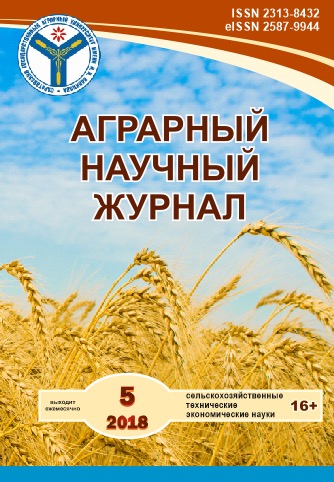Use of humic acids in cattle production
DOI:
https://doi.org/10.28983/asj.v0i5.472Keywords:
agriculture, humic acids, feeding, cattle production, immune systemAbstract
This present study was to investigate make propositions on the possible use of humic acids in cattle production. Study on the effects of a mixture of charcoal, sauerkraut juice and humic acidson cattles fed with GMO feeds containing glyphosates showed an increase in fecal gram-negative bacteria and a subsequent increase in general health of the cows. Also a study on the use of sauerkraut juice ,charcoal and humic acid mixture on cows with chronic botulism , showed reduction in antibody levels of C.botilium ABE and CD. At the end of a 24 week study the study animals were
returned to normalcy and also had increased immunity.
Downloads
Download data is not yet available.
References
1. Barry G., Padgette S.R. (1992) Glyphosate tolerant 5-enolpyruvylshikimate-3phosphate synthases. World Patent WO 92/04449.
2. Bohnel H., Schwagerick B., Gessler F. (2001) Visceral botulism--a new form of bovine Clostridium botulinumtoxication // J Vet Med A PhysiolPatholClin Med 48: 373–383.
3. Cerdeira A.L., Duke S.O. (2006) The current status and environmental impacts of glyphosate-resistant crops: a review.// J Environ Qual 35: 1633–1658.
4. Gerlach H., Gerlach A., Schrodl W., SchottdorfB., Haufe S.et al. (2014) Oral application of charcoal and humic acids to dairy cows influences Clostridium botulinum blood serum antibody level and glyphosate excretion in urine // J CIinical-Toxicol 186: 2161–0495.
5. Gerlach H., Gerlach A., Schrodl W., Haufe S., Schottdorf B. (2014) Oral Application of Charcoal and Humic Acids Influence Selected Gastrointestinal Microbiota, Enzymes, Electrolytes, and Substrates in the Blood of Dairy Cows Challenged with Glyphosate in GMO Feeds. J Environ Anal Toxicol
4: 256. doi: 10.4172/2161-0525.1000256.
6. Kruger M., Grosse-Herrenthey A., Schrodl W., Gerlach A., Rodloff A. (2012) Visceral botulism at dairy farms in Schleswig Holstein, Germany: prevalence of Clostridium botulinum in feces of cows, in animal feeds, in feces of the farmers, and in house dust. Anaerobe 18: 221–223.
7. Mazzei P., Piccolo A. (2012) Quantitative evaluation of non-covalent interactions between glyphosate and dissolved humic substances by NMR spectroscopy. Environ SciTechnol 46: 5939–5946.
8. Shehata A.A., Kuhnert M., Haufe S., Kruger M. (2013) Neutralization of the antimicrobial effect of glyphosate by humic acid in vitro // J chemosphere 10: 258–261.
9. Stevenson F.J. (1982) Humus Chemistry, Wiley, N.Y.
10. Vasiliev A.A. Value, theory and practice of using humic acids in animal husbandry / A.A., Vasiliev, A.P. Korobov, S.P. Moskalenko, L.A. Sivokhina, M.Yu., Kuznetsov // Agrarian Scientific Journal, No. 1, 2017, P. 3–6.
2. Bohnel H., Schwagerick B., Gessler F. (2001) Visceral botulism--a new form of bovine Clostridium botulinumtoxication // J Vet Med A PhysiolPatholClin Med 48: 373–383.
3. Cerdeira A.L., Duke S.O. (2006) The current status and environmental impacts of glyphosate-resistant crops: a review.// J Environ Qual 35: 1633–1658.
4. Gerlach H., Gerlach A., Schrodl W., SchottdorfB., Haufe S.et al. (2014) Oral application of charcoal and humic acids to dairy cows influences Clostridium botulinum blood serum antibody level and glyphosate excretion in urine // J CIinical-Toxicol 186: 2161–0495.
5. Gerlach H., Gerlach A., Schrodl W., Haufe S., Schottdorf B. (2014) Oral Application of Charcoal and Humic Acids Influence Selected Gastrointestinal Microbiota, Enzymes, Electrolytes, and Substrates in the Blood of Dairy Cows Challenged with Glyphosate in GMO Feeds. J Environ Anal Toxicol
4: 256. doi: 10.4172/2161-0525.1000256.
6. Kruger M., Grosse-Herrenthey A., Schrodl W., Gerlach A., Rodloff A. (2012) Visceral botulism at dairy farms in Schleswig Holstein, Germany: prevalence of Clostridium botulinum in feces of cows, in animal feeds, in feces of the farmers, and in house dust. Anaerobe 18: 221–223.
7. Mazzei P., Piccolo A. (2012) Quantitative evaluation of non-covalent interactions between glyphosate and dissolved humic substances by NMR spectroscopy. Environ SciTechnol 46: 5939–5946.
8. Shehata A.A., Kuhnert M., Haufe S., Kruger M. (2013) Neutralization of the antimicrobial effect of glyphosate by humic acid in vitro // J chemosphere 10: 258–261.
9. Stevenson F.J. (1982) Humus Chemistry, Wiley, N.Y.
10. Vasiliev A.A. Value, theory and practice of using humic acids in animal husbandry / A.A., Vasiliev, A.P. Korobov, S.P. Moskalenko, L.A. Sivokhina, M.Yu., Kuznetsov // Agrarian Scientific Journal, No. 1, 2017, P. 3–6.








